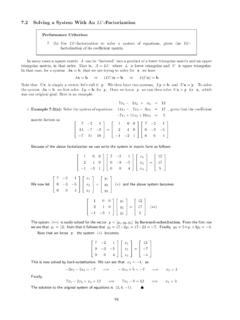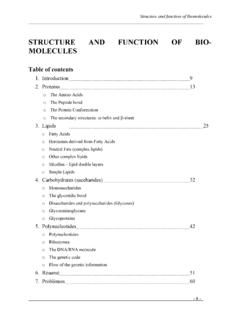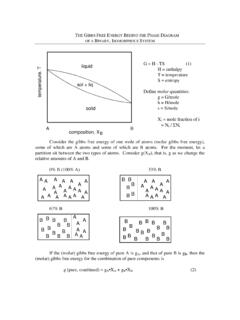Transcription of 5 Linear Transformations - Oregon Institute of Technology
1 5 Linear Transformations Outcome: 5. Understand Linear Transformations , their compositions , and their application to homogeneous coordinates. Understand representations of vectors with respect to different bases. Understand eigenvalues and eigenspaces, diagonalization. Performance Criteria: (a) Evaluate a transformation. (b) Determine the formula for a transformation in R2 or R3 that has been described geometrically. (c) Determine whether a given transformation from Rm to Rn is Linear . If it isn't, give a counterexample; if it is, prove that it is. (d) Given the action of a transformation on each vector in a basis for a space, determine the action on an arbitrary vector in the space.
2 (e) Give the matrix representation of a Linear transformation. (f) Find the composition of two Transformations . (g) Find matrices that perform combinations of dilations, reflections, rota- tions and translations in R2 using homogenous coordinates. (h) Determine whether a given vector is an eigenvector for a matrix; if it is, give the corresponding eigenvalue. (i) Determine eigenvectors and corresponding eigenvalues for Linear trans- formations in R2 or R3 that are described geometrically. (j) Find the characteristic polynomial for a 2 2 or 3 3 matrix. Use it to find the eigenvalues of the matrix. (k) Give the eigenspace Ej corresponding to an eigenvalue j of a matrix.
3 (l) Determine the principal stresses and the orientation of the principal axes for a two-dimensional stress element. (m) Diagonalize a matrix; know the forms of the matrices P and D from P 1 AP = D. (n) Write a system of Linear differential equations in matrix-vector form. Write the initial conditions in vector form. (o) Solve a system of two Linear differential equations; solve an initial value problem for a system of two Linear differential equations. 7. Transformations of Vectors Performance Criteria: 5. (a) Evaluate a transformation. (b) Determine the formula for a transformation in R2 or R3 that has been described geometrically.
4 Back in a regular algebra class you might have considered a function like f (x) = x + 5, and you may have discussed the fact that this function is only valid for certain values of x. When considering functions more carefully, we usually declare the function before defining it: . Let f : [ 5, ) R be defined by f (x) = x + 5. Here the set [ 5, ) of allowable inputs is called the domain of the function, and the set R is sometimes called the codomain or target set. Those of you with programming experience will recognize the process of first declaring the function, then defining it. Later you might call the function, which in math we refer to as evaluating it.]]
5 In a similar manner we can define functions from one vector space to another, like . x1 + x2. x1. Define T : R2 R3 by T = x2.. x2.. x21. We will call such a function a transformation, hence the use of the letter T . (When we have a second transformation, we'll usually call it S.) The word transformation implies that one vector is transformed into another vector. It should be clear how a transformation works: . 3. Example (a): Find T for the transformation defined above. 5.. 3 + 5 2. 3. T = 5 = 5 .. 5 2. ( 3) 9. It gets a bit tiresome to write both parentheses and brackets, so from now on we will dispense with the parentheses and just write.
6 2. 3. T = 5 . 5. 9. At this point we should note that you have encountered other kinds of Transformations . For example, taking the derivative of a function results in another function, d 3. (x 5x2 + 2x 1) = 3x2 10x + 2, dx so the action of taking a derivative can be thought of as a transformation. Such Transformations are often called operators. Sometimes we will wish to determine the formula for a transformation from R2 to R2 or R3 to 3. R that has been described geometrically. 8. Example (b): Determine the formula for the transformation T : R2 R2 that reflects vectors across the x-axis. Solution: First we might wish to draw a picture to see what such a 4.
7 Transformation does to a vector. To the right we see the vectors u= . T v . [3, 2] and v= [ 1, 3], and their Transformations T u= [3, 2] and u . T v= [ 1, 3]. From these we see that what the transformation does is change the sign of the second component of a vector. Therefore -4 4.. x1 x1 . T u T = . v-4. x2 x2. Example (c): Determine the formula for the transformation T : R3 R3 that projects vectors onto the xy-plane. Solution: It is a little more difficult to draw a picture for this one, but to the right you can see an attempt to illustrate the action of this z . transformation on a vector u. Note that in projecting a vector onto the.
8 U xy-plane, the x- and y-coordinates stay the same, but the z-coordinate becomes zero. The formula for the transformation is then . x x y y T y = .. z x T u 0. Let's now look at the above example in a different way. Note that the xy-plane is a 2-dimensional subspace of R3 that corresponds (exactly!) with R2 . We can therefore look at the transformation as T : R3 R2 that assigns to every point in R3 its projection onto the xy-plane taken as R2 . The formula for this transformation is then . x . x T y =.. y z We conclude this section with a very important observation. Consider the matrix . 5 1. A = 0 3 . 1 2.. and define TA x= A x for every vector for which A x is defined.
9 This transformation acts on vectors in R2 and returns vectors in R3 . That is, TA : R2 R3 . In general, we can use any m n matrix A to define a transformation TA : Rn Rm in this manner. In the next section we will see that such Transformations have a desirable characteristic, and that every transformation with that characteristic can be represented by multiplication by a matrix. 9.. 3. Example (d): Find TA , where TA is defined as above, for the matrix given. 1.. 5 1 14. 3 3. Solution: TA = 0 3 = 3 . 1 1. 1 2 5. Section Exercises To Solutions 1. For each of the following a transformation T is declared and defined, and one or more vectors.
10 U, v and w is(are) given. Find the transformation(s) of the vector(s), labelling your answer(s). correctly.. x1 x1 x2 1 2. (a) T : R2 R2 , . T = , u = , v =. x2 x22 1 3.. x1 + x2 . 2 3 x1 1 2. (b) T : R R , T = 3x2 , u = , v =. x2 1 3. x1.. x1 x1 + x2 1 2. (c) T : R3 R3 , . T x2 = x2 + x3 , v = 1 , w = 3 . x3 x3 + x1 1 5.. x1 x3 1. x2 x4 2 . (d) T : R4 R4 , . x3 = x1. T , u = . 3 . x4 x2 4.. x1 x1 + 5 1 2. (e) T : R3 R3 , . T x2 = x2 2 , u = 1 , w = 3 . x3 x3 + 1 1 5.. x1 x2 x1 2. x2 x3 x2 7 . R5 R5 , . (f) T : T . x3 = . x4 x3 , v = . 5 .. x4 x5 x4 4 . x5 x5 1. 2. For each of the Transformations in Exercise 1, determine whether there is a matrix A for which T = TA , as described in the Example (d) and the discussion preceeding it.









